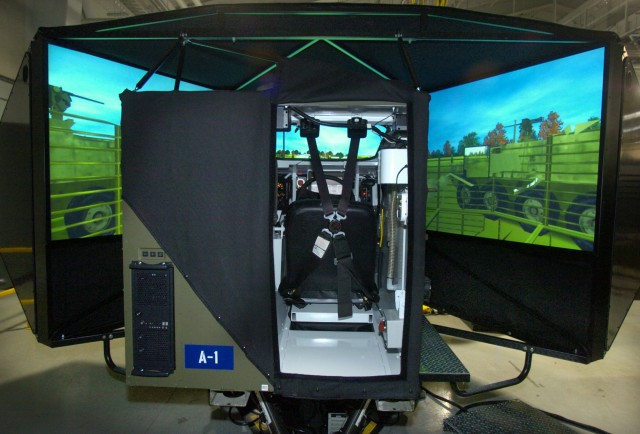FORT LEWIS, Wash. (Army News Service, April 27, 2007) - New Stryker simulators at the John A. Pittman Mission Support Training Facility here are already earning their keep.
Perhaps the most realistic training simulator to date, the Common Driver Trainer/Stryker Variant is designed to provide initial training for drivers and vehicle commanders on all 10 variants of the Army's workhorse urban combat vehicle. The $800,000 simulators are expected to save lives, money and time.
An additional nine simulators are scheduled for delivery during the next six months to installations across the country, according to Program Director Dr. James Blake of Program Executive Office for Simulation, Training and Instrumentation.
"Stryker drivers will be able to familiarize themselves with the controls and dynamics of their individual variant of Stryker before operating the vehicle," deputy commander of I Corps, Brig. Gen. William Troy, told Soldiers and press April 16 at an MSTF ribbon-cutting ceremony.
"Drivers will be able to do things that are dangerous in the real world - driving on ice, fording streams, driving under blackout conditions, driving down a steep embankment, all without risking injury or the loss of a vehicle," said Brig. Gen. Troy.
Fort Lewis may receive up to four of the trainers, which would enable company commanders to coordinate platoon maneuvers. The developers' goal is to tie the simulator's computers into video games the Army currently uses for training, to provide even more realistic small-unit training.
Soldiers already familiar with the Stryker have marveled at the Common Driver Trainer's exact duplication of the original.
"The inside of the Stryker looks exactly the same. The feel of it and functionality of all the buttons and levers - when you get into it, you have the feel exactly of a Stryker," said Cpl. Matt Hewitt, an Operation Iraqi Freedom veteran with 1st Battalion, 17th Infantry Regiment. "Somebody could get inside a simulator, drive around a little bit, then get in a real one and know exactly what they're doing. It wouldn't surprise me one bit."
A console behind the pod gives the vehicle commander a view of a large computer screen, segmented into four quadrants. Two give the VC a view of the driver to make sure he is properly checking his mirrors and gauges. The bottom two provide views of the surroundings, smaller versions of the display that serves as the driver's view. But that's only the beginning.
"We've loaded 50 scenarios off road, heavy traffic, desert and urban areas," said Matt Latimer, a representative of Science Applications International Corporation, whose joint effort with PEO STRI of Orlando developed the simulators. "I can adjust his environment at any time. I can pick up the wind; I can bring in cold, foggy snow, which will create ice on the road. The tires will start slipping. I can even do a sandstorm."
Evaluators can kill oil pressure to gauge a driver's reaction or detonate an improvised explosive, causing the vehicle to rock violently. They can even weigh down the Stryker with slat armor and a full combat load.
All the while, a digital video recorder makes a record of the driver's actions and reactions. A commander can burn a disk of the complete record of a simulator session for training purposes to take back to his unit, and print a paper output of each driver's score with a place for a trainer's comments. Soldiers' identities are also saved in the system as historical data for later access.
"This training capability is going to save lives in combat," said Brig. Gen. Troy, "and it's going to give us a more capable force than we've had before. This is a great step."
(Don Kramer writes for the Fort Lewis "Northwest Guardian.")


Social Sharing